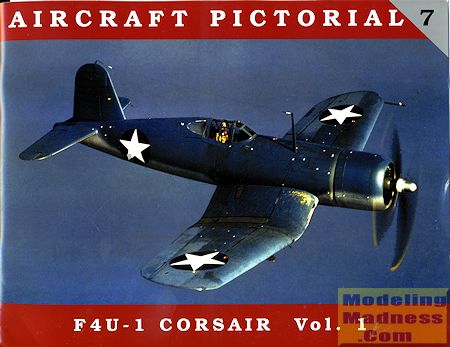Aircraft Pictorial #7: F4U-1 Corsair
Vol 1
 Sporadically
books from this series arrive at the editorial offices and it was with some
interest that the latest in Classic Warships Publishing's Aircraft Pictorial
series arrived in the mails. Typical of this series, no warbirds were used in
the publishing of this edition, something I find refreshing. All of the images
are period photos and include several in full color and of very high quality.
Sporadically
books from this series arrive at the editorial offices and it was with some
interest that the latest in Classic Warships Publishing's Aircraft Pictorial
series arrived in the mails. Typical of this series, no warbirds were used in
the publishing of this edition, something I find refreshing. All of the images
are period photos and include several in full color and of very high quality.
The Corsair is an aircraft about which
one would think that there was nothing new to be learned. However, as is often
the case, that is rather far from the truth. There is much speculation, innuendo
and down right incorrect information about the early Corsairs that has been
passed down from year to year.
In this book, author Dana Bell provides
the results of a lot of primary research to either verify or debunk some of that
information. The first bit of info the go to the wayside is that the Corsair was
not used aboard carriers because it bounced too much upon landing. The truth is
that planners of the time did not want to have an additional supply chain of
parts to carry aboard aircraft carriers so chose, until later in the war, to
concentrate on the Hellcat, which was already in fleet service and proving to be
quite adequate for the job.
We also learn about the 'salmon' primer,
which at the time was called Indian Red. This was a result of options available
to mix in with zinc chromate primer (a yellowish shade). One was aluminum paste
which produced a candy apple green color and was rarely used. Another was
aluminum paste and black which produced the standard yellow-green color. The
third was to use iron oxide, which produced the Indian Red color. Very early
planes had cockpits in a dull dark green, but most of the rest used the Indian
Red primer. Most other places that needed additional protection (gear wells and
inner gear doors, for instance, got a coat of the underside color. Since many
component sections were not built by Vought, you can easily find different
primer shades on the same airframe.
There is other interesting information
for modelers regarding the various camouflage colors used through the production
of the early Corsair, with some schemes being quite new to me and not at all
what I'd have expected.
The rest of the book covers such areas as
the changes in antenna masts, the use of reinforced 'turtle decks' behind the
cockpit that removed the plexiglas panels, the development of bomb racks and
wing tank racks by VF-17, reinforced and extended tail gear, issues with fuel
leaking into the fuselage, the lower bomb aiming window and much more.
All this is accompanied with large and
crisply printed images as well as informative photo captions. It is a book that
I would have to say is very much a 'must have' issue for those who are Corsair
fans and those just wanting to know more about the plane. It is a book I most
highly recommend and am looking forward to the second volume.
December 2014
Review copy courtesy of
Classic Warships Publishing. They have a full selection of
Nautical titles you will like. When you shop there, say Modeling Madness sent you.
If you would like your product reviewed fairly and quickly, please
contact
me or see other details in the Note to
Contributors.
 Sporadically
books from this series arrive at the editorial offices and it was with some
interest that the latest in Classic Warships Publishing's Aircraft Pictorial
series arrived in the mails. Typical of this series, no warbirds were used in
the publishing of this edition, something I find refreshing. All of the images
are period photos and include several in full color and of very high quality.
Sporadically
books from this series arrive at the editorial offices and it was with some
interest that the latest in Classic Warships Publishing's Aircraft Pictorial
series arrived in the mails. Typical of this series, no warbirds were used in
the publishing of this edition, something I find refreshing. All of the images
are period photos and include several in full color and of very high quality.